Category: Hunting Blog
The First Rule Of Deer Management
It’s important to consider how to make a property “huntable” or hunter friendly for mature bucks. For a property to be huntable for mature bucks there are several factors that must be considered.
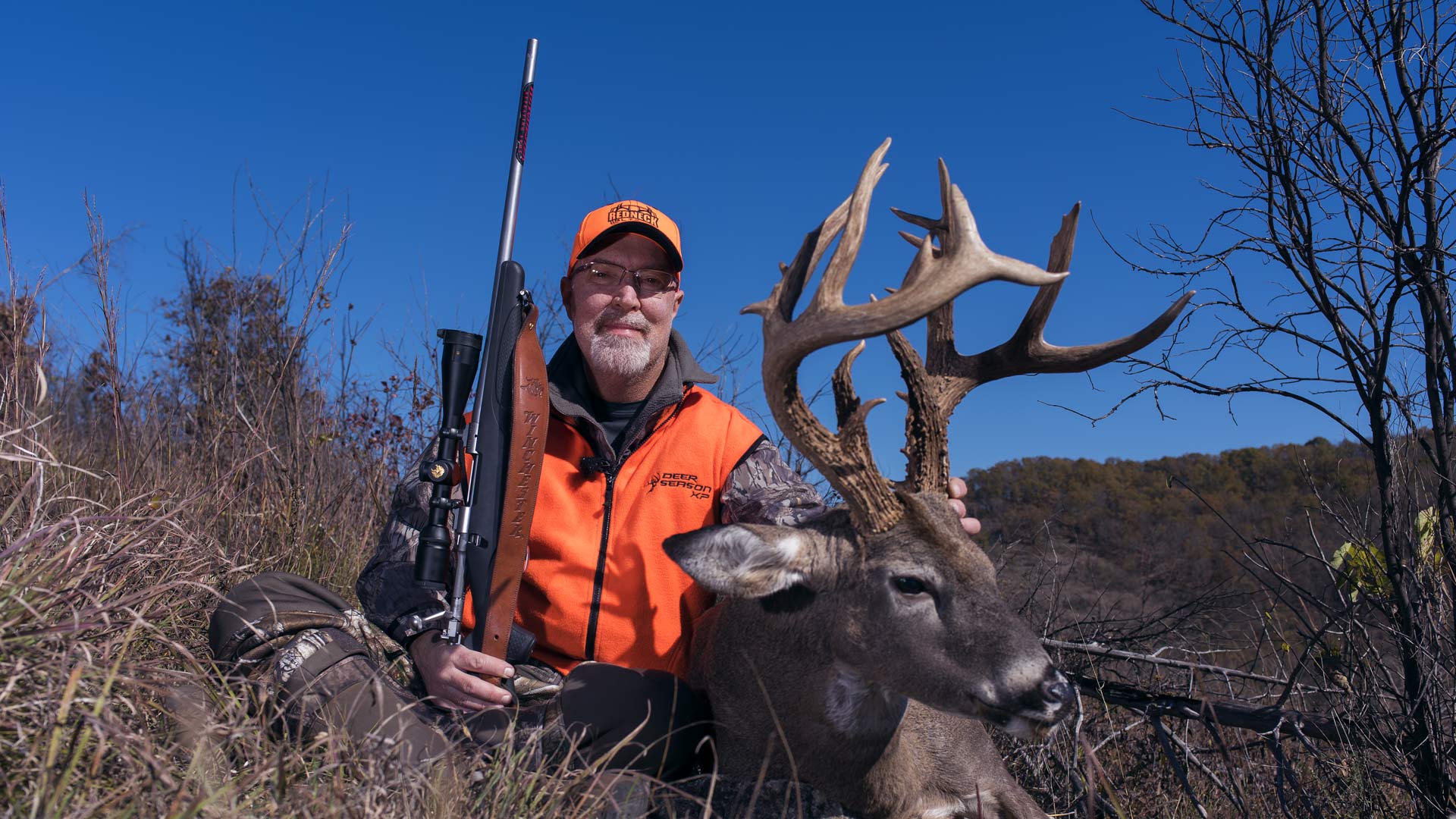
Have realistic expectations. This is the first step to hunting satisfaction. It is important to understand that having huntable, mature bucks doesn’t mean there will be a Boone & Crockett class buck behind every tree. A buck is mature to me when they are four years old or older. This is because most of their skeletal development is complete and they can use most of their excess resources to produce bigger antlers. Few free-ranging bucks express their genetic potential due to limitations in habitat quality.
Have more mature bucks. To get more mature bucks, immature bucks must be passed and allowed to grow. Dead deer don’t grow. It sounds simple, but some hunters still don’t understand. They harvest a good looking two year old buck and then complain that they never harvest a “monster buck.” They’ve probably harvested several monster bucks. They just shot them before they matured and produced large antlers!
Bucks typically produce larger antlers as they age. Research shows that two and three year old bucks produce, on average, about 50 and 75% of their antler growth potential. It’s not until bucks mature to four years old or older that they express, on average, about 94% of their antler growth potential. To have an opportunity to harvest mature bucks, you must hunt where bucks are allowed to mature. The more bucks that are allowed to live to 4+ years of age, the easier it will be to harvest a mature buck.
Trigger finger management is the least expensive form of deer management. It simply costs less to pass immature bucks than any other form of management for establishing a hunter friendly population of mature bucks.
If you want to tag a mature buck, be prepared to pass immature bucks. Yes, others in your area may kill immature bucks. But, the trend must start somewhere and it is most likely to start with you. Share the education with other hunters in your area. You don’t have to convince all of them, but you won’t convince any of them when gathered around an immature buck you just harvested.
Remember, the first rule of deer management, “Dead Deer Don’t Grow.”
Enjoy Creation,
Grant
Creating A Great Hunting Location
Last week we finished planting! The cereal rye was successfully crimped by the Goliath and Eagle Seed beans are already germinating through the terminated rye! During the following months, the Eagle Seed forage soybeans will supply our deer herd with quality forage. Not only do we plant quality forage to promote healthy deer, it is a great way to attract deer and create a great hunting location this deer season!
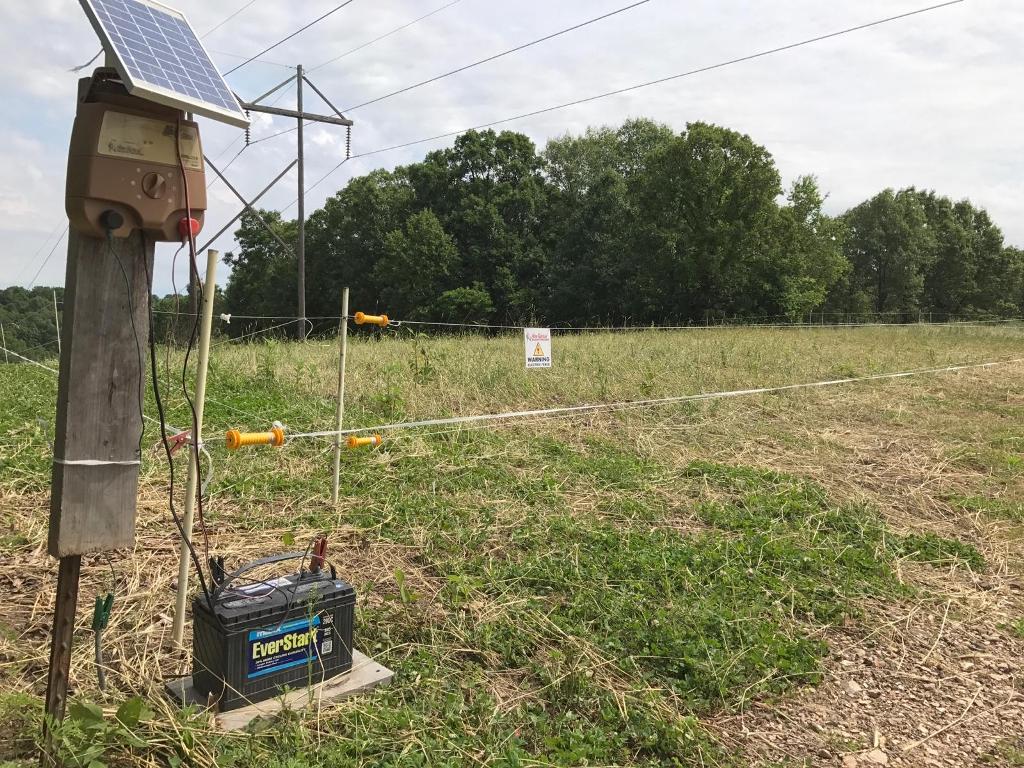
This plot is within bow range of our Summit stands and will be a great hunting location when deer are eating standing grains!
Every year we protect a portion of our Eagle Seed beans during the summer months with a Non-Typical Hot Zone Fence in select locations. This ensures that even though deer may browse outside of the fence, they do not consume all the forage in the area. When season rolls around, we can simply open the fence and have a great food source to hunt over!
Here are the steps to take when setting up your Hot Zone fence:
1. Create the fence with your hunting strategy in mind. Think of where your stand or blind will be located in relation to the fence/food source. Consider which wind to hunt and how to enter and exit without alerting deer.
2. Build the fence as soon as beans begin to germinate. You do not want deer to associate the beans inside the fence as a food source. This will decrease the chances that deer will try to jump the fence to feed inside.
3. Make sure it is set up correctly. The Hot Zone electric fence works because it is designed as a two fence (3 strand) barrier. The outside fence has a thick, tape-like polyline that should be strung 18 inches from the ground. Three feet inside the outer fence there should be another fence that has two stands of polyline. The lower wire should be 10 inches from the ground and the top wire 24 inches from the ground.
4. Keep the electric fence turned on ALL summer. If the fence is not on during a portion of the summer, deer will learn that they can jump it with out consequences and will do so even when it is turned on.
5. Open the fence when the conditions are right for hunting! If you open the fence when it is hot and deer are feeding during the night, they can easily lick the field clean during several nights (depending on the size of the field). Or if there is not a suitable wind forecasted for hunting, deer can browse it quickly before you are able to effectively hunt.
If you’re a small food plotter and wish to save quality forage for early deer season or wish to allow beans to mature so that you can hunt over standing grain this winter, the preparation starts now! Stay tuned this summer as we share updates about our food plots and hunting strategies as we prepare for fall!
Enjoying Creation,
Daniel
Maximize The Growing Season!
Sadly, Missouri’s turkey season recently ended. However, we feel much better knowing antlers are growing and fawns are dropping! Before long, it will be deer season. With deer season in sight, it’s important that all of our Trophy Rock stations are refreshed and ready for the upcoming growing season.
We keep many of our Trophy Rock sites out all year. Why? Because deer need minerals all year. We want does to be healthy in the winter when fawns are only a few weeks into development. We want to help bucks make it through the rut and the harsh winter conditions. However, deer tend to require larger amounts of mineral during the antler development, fawning and milk producing season (late spring and summer). During this time, it is especially important that all our Trophy Rock stations are full and there is plenty of mineral available to deer.
We prefer Trophy Rock because it has 60+ natural micro and macro nutrients! Deer may only need very small amounts of some of these minerals. However, if these trace minerals are not available to deer, it can keep bucks, does, and fawns from reaching their potential. If you want your deer herd to be healthy and reach their maximum potential this growing season, Trophy Rock is a great start!
I hope you are able to get Trophy Rock out on your property and begin monitoring the results with trail cameras. It won’t be long before it’s time to pattern deer and create the 2017 hit list.
Enjoying Creation,
Daniel
Preparing For Summer: Ticks
Here at The Proving Grounds it seems like summer is just around the corner. Antlers are growing, fawns will be dropping any day and Eagle Seed soybeans are being planted. Soon we will be hanging Summit Stands, trimming lanes and beginning several habitat projects. That means a lot of time in the woods.
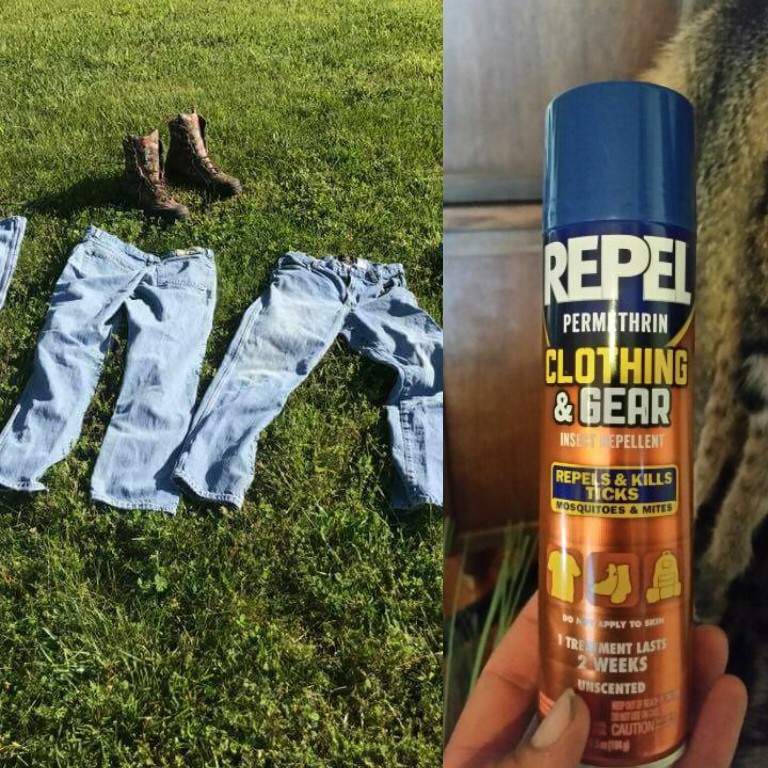
We lay all our clothes out on the ground and spray both the front and back with permethrin.
As many hours as we spend in the woods, we come across lots of ticks! Ticks can carry many diseases. We help protect our deer herd from these by feeding Antler-X-Treme which reduces ticks and other parasites, but what about us? Tick-borne diseases can be harmful, and in some cases, fatal to humans. Tick-borne diseases such as Rocky Mountain spotted fever or Lyme disease are serious and precautions need to be considered before heading into the woods this summer.
Before we enter the woods, we spray all our clothes with Permethrin. Permethrin repels and even kills ticks. One treatment will often last up to two weeks and several washings. However, Permethrin should not be applied to your clothes while wearing.
We lay out all our clothes that we will be using in the field, spray them with Permethrin and then let them dry before wearing. This has greatly reduced the number of ticks that we find after being in the woods. Fewer ticks mean there is less of a chance of contracting a tick-borne disease.
If you are planning to be in the woods this summer, start preparing now. Treat your clothes with permethrin or find another tick repellant and enjoy Creation without having to worry about ticks.
Enjoying Creation,
Daniel
The Benefits Of Roller Crimping
Earlier this week I was turkey hunting in Kansas. As my hunting partner and I drove around looking for toms on public land, I noticed that many farmers had begun preparing for planting season. There were one or two farmers that gambled on good weather and had already put seed in the ground several weeks earlier. Everyone else was just starting to spray or work their fields.
As we walked across some large ag fields in search of toms, I couldn’t help but notice how bare and dry the soil was. I picked up several clumps of dirt and with a slight squeeze watched as they fell apart. Not ideal soil. On top of that, I noticed erosion. Even in fields that had been terraced (designed and built to reduce erosion) and planted with the contour of the land, there were signs of water erosion.
During the hunt, I couldn’t help but compare my observations in Kansas to those at The Proving Grounds. There was one obvious difference, the use of cover crops.
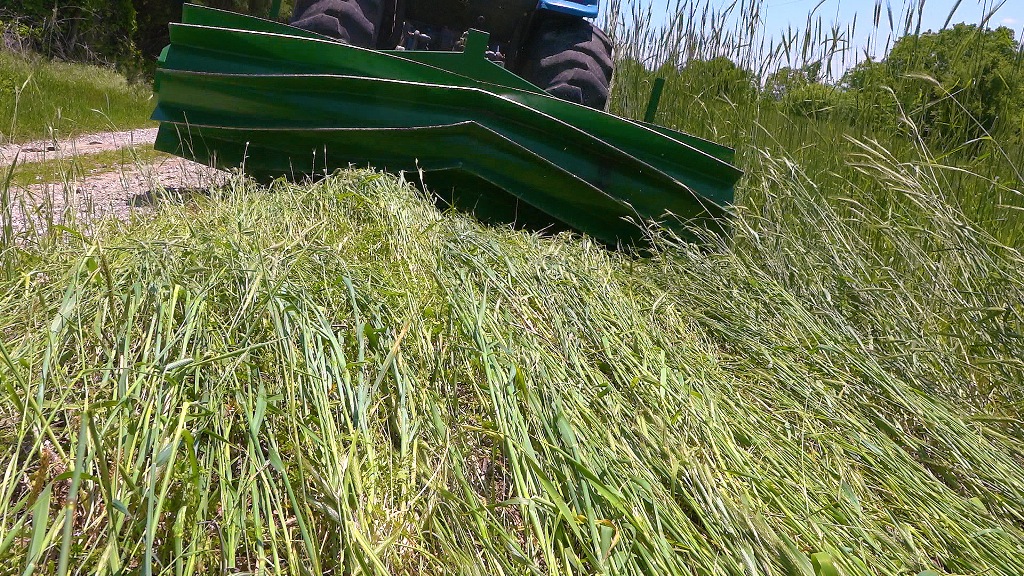
The roller crimper lays the winter rye down while crushing the stem, terminating the crop without the use of herbicide.
The soil at The Proving Grounds is never left uncovered. Last summer we mixed winter rye into Eagle Seed Broadside for a fall food plot blend. The winter rye has grown very well and helped hold moisture in the soil. We had several torrential rainfalls that eroded our roads but left our food plots unscarred. Our soil is still intact and healthy.
Like many farms we are preparing for planting, only we will be planting small summer food plots. We too will terminate the vegetation in our fields (in our case the winter rye) before we plant Eagle Seed soybeans. We terminate the rye to reduce the soybeans’ competition for nutrients, water, etc.
Unlike the farmers I watched spray weeds, we do not have many weeds in our plots. The winter rye has kept weeds from growing. One great thing about using the winter rye to protect our fields from erosion and weeds is that we are able to terminate the rye without the use of herbicide. We simply use a roller crimper.
A roller crimper, like a traditional roller, will lay the vegetation down. However, the addition of the crimper’s angled metal outcroppings will break the stem on the rye. By breaking the stem, the rye can no longer carry water or nutrients throughout the stalk and dies. This dead vegetation is now left on the soil and becomes a slow releasing fertilizer building organic matter and creating a layer of mulch that protects the soil from erosion, moisture loss, and weeds. The process of roller crimping replicates what large herds of buffalo did on the great prairie years ago as they trampled the native vegetation. This is exactly what created the soil that farmers in Kansas and other states now benefit from.
Though I was unsuccessful tagging a tom in Kansas, the trip was a gentle reminder of the differences in land management practices. As land managers, we can have great benefits (healthier soil) and cost reduction (reduced herbicide and fertilizer) by how we chose to manage our food plots this spring. Stay tuned this growing season as we keep you updated on our food plot management techniques!
Enjoying Creation,
Daniel Mallette
The Power Of Cover Crops
Over the past several weeks we have had a lot of rain at The Proving Grounds. Our neighbor poured out 11+ inches from his rain gauge during one weekend. Talk about a toad straggler!
Water can be a powerful force. There are many that have had massive damage to their homes and properties. We had substantial damage at The Proving Grounds. The main road of our property runs through a bottom along the base of the Ozark Mountains. Like many low areas in mountainous country, there is a small stream that passes through. In torrential downpours, like the one we recently experienced, the creek rises very fast due to the runoff from the mountains. When these occasional rainstorms roll in there is a lot of water that moves through the property very quickly!
Not only are the road and creek located in these low terrain areas, but so are many of our food plots. With thousands of gallons of water rushing through our food plots as the creeks overflow, you would think it would wash away our food plots. Not so.
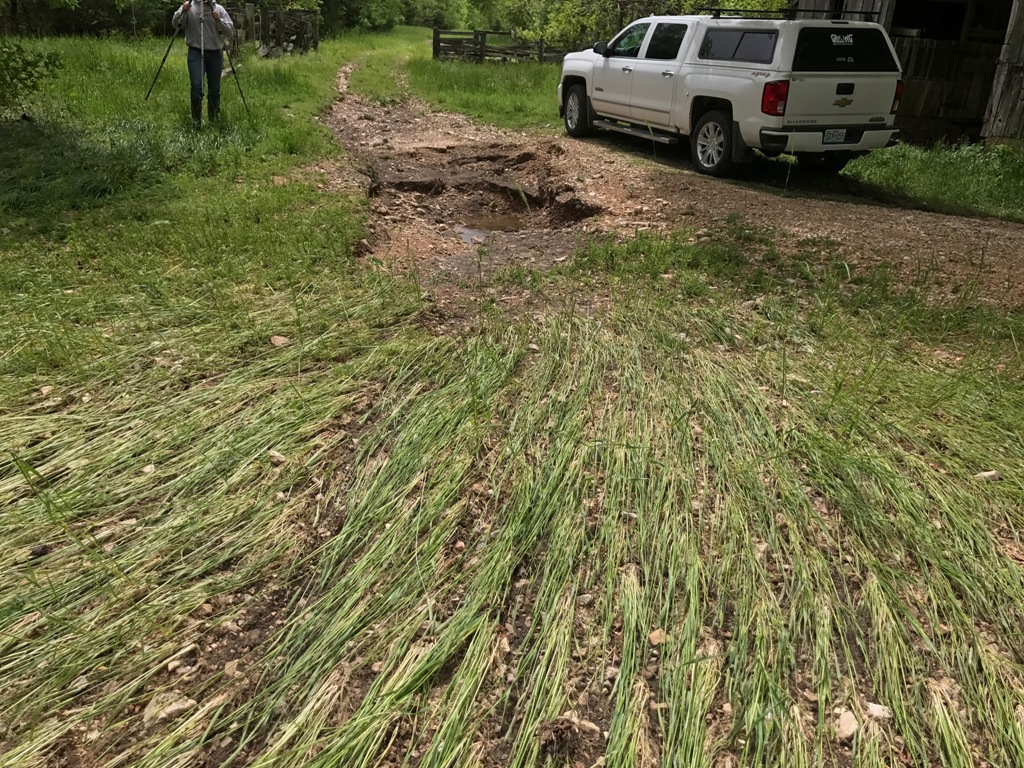
Notice how the erosion stopped when the water hit the cover crop!
The majority of the damage left in the wake of the recent storm was focused on our roads (where no vegetation grew). Several portions of the road (which runs through many of our food plots) washed completely out. Our food plots show no signs of erosion and still have our cover crop in place. To be honest, we are shocked! This is a great example of the power and value of food plot cover crops.
Cover crops have many benefits. They pull nutrients up the soil profile, making them available to food plot crops. Cover crops protect the soil from wind and water erosion, hold soil moisture, help reduce weeds, and promote healthy soil structure among many other things.
Last fall we planted a cover crop of cereal rye. This spring the rye shot up and is now protecting our soil until we are able to plant Eagle Seed soybeans. The cereal rye has done many things for our soil but one of the most impressive is holding our food plots intact through massive flooding. It’s hard to imagine what our food plots would have looked like if they had no protection by a cover crop.
Stay tuned throughout the year as we explain step-by-step our food plot planting and management techniques!
Enjoying Creation,
Daniel
Burning Is For The Birds!
Burn, burn, burn! As most followers of GrowingDeer know, burning is not only a major tool we use to improve habitat but it could easily be one of most beneficial ways to improve the habitat quality on any property. Prescription burning is inexpensive, controls unwanted plant species, provides highly desirable forage, and includes a countless number of other benefits to wildlife. And did I mention turkeys?!
One result from years of prescribed burning is the flourishing population of turkeys we have on The Proving Grounds. Turkeys were few and far between when Grant purchased this property 15 years ago. However, after many years of improving the habitat through burning and increasing food sources there is now a thriving, huntable population of turkeys that call The Proving Grounds home.
Fire eliminates old growth and stimulates the growth of new, beneficial forbs and grasses. By reducing the amount of fuel on the ground, the soil surface becomes exposed and allows turkey poults to easily move across the land while foraging for insects. Bugging habitat is crucial for young turkeys and the insect populations that prosper on these burned areas provide the nutritional requirements poults need to grow.
The exposed seeds, insects, and newly growing forbs on burn sites provide a smorgasbord of food for turkeys. These areas become turkey magnets during the spring and summer! Our Reconyx trail cameras show high turkey activity in the burned glades on the property as proof. Additionally, and perhaps most importantly for hunters, these burned areas often produce excellent spring turkey hunting. The crops of the turkeys we harvested this spring were full of new vegetation that is growing prolifically in our prescription burn units. This is just further evidence of the benefits burning provides for turkeys.
If you are not burning on your property and love to chase gobblers, maybe this information will convince the land manager in you to burn next year! Take a fire class, gain some in-field experience, and witness the benefits of prescription burning yourself.
Enjoy Creation,
Tyler
Warning: This blog contains information about prescribed fire which is a management tool for trained professionals using the appropriate tools for the situation.
Gobbler Getting Decoy Strategies
Turkey season is in full swing and many hunters are experiencing success. I recently tagged a couple of nice toms in Kansas using two common decoy strategies. I found the first bird strutting in a pasture accompanied by three hens and he quickly fell prey to a tactic known as reaping or fanning. I struck up a gobble soon after bagging my first tom and within a few minutes there was a pair of big longbeards in front of me. The end result was me wrapping my last Kansas tag around the leg of an old Rio Grande gobbler. There are countless ways to use decoys for turkey hunting so I will break some of those methods down into easy to understand steps.
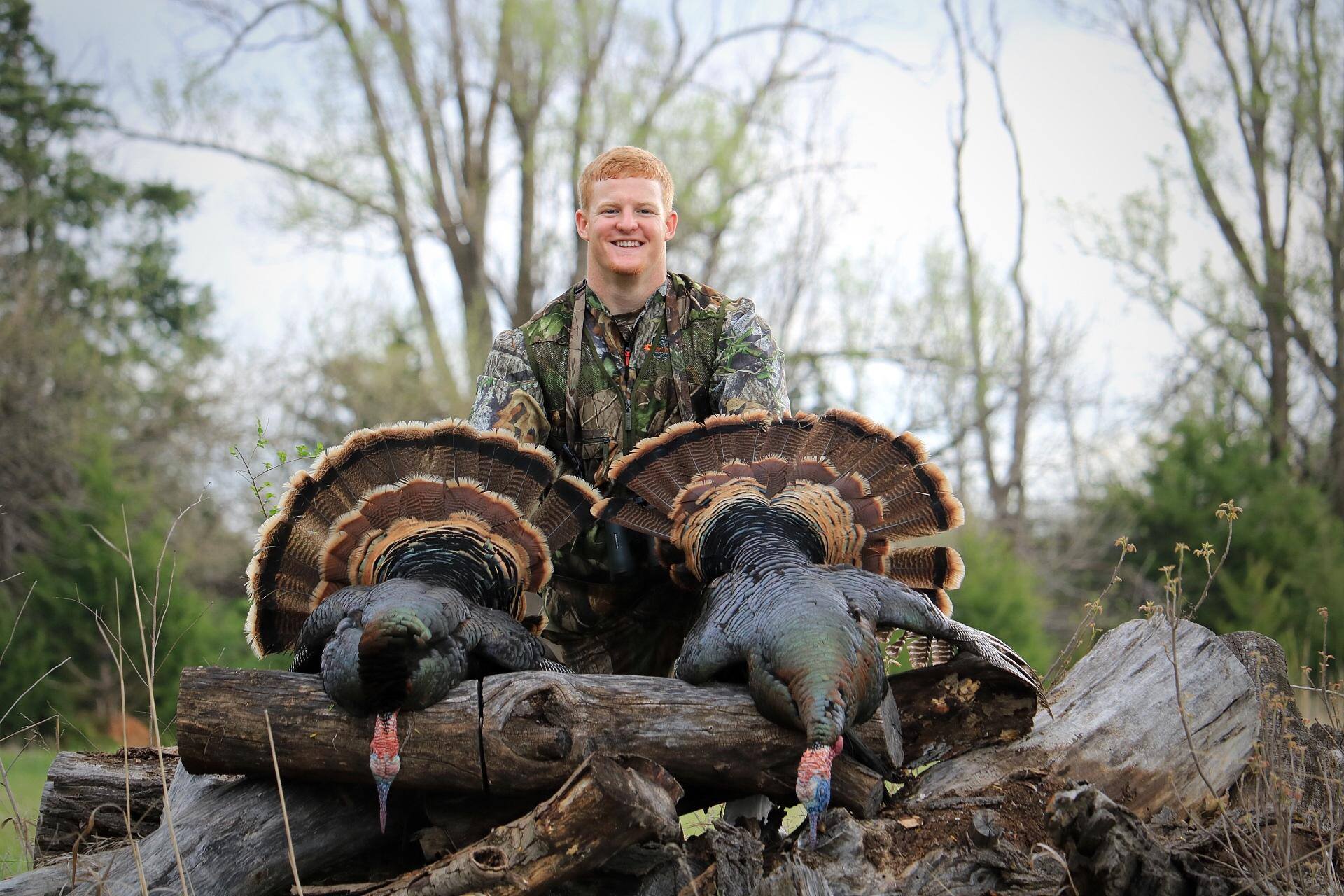
I bagged a couple of nice toms in Kansas using two common decoy strategies.
Know the current breeding phase of the flock you are hunting. In some states, turkey season opens during late March. Often birds are still flocked up and large decoy set-ups with multiple hens and a jake or tom work very well. As the season progresses, flocks break up, males assert dominance, and hens prepare for breeding. The peak breeding phase occurs around the middle of April and this is a great time to use a standing or lay-down hen accompanied by a jake decoy. Most gobblers cannot resist the urge to breed a hen and the presence of an inferior jake will get them fired up. After most hens are bred, they go to nest. Toms and jakes will then be searching hard for any remaining unbred hens. This phase usually occurs during late April or May and one of the best decoy tactics for this time is a single hen looking for love. Montana Decoy offers a full line of turkey decoys to cover any of the situations I mentioned.
Another popular decoy strategy is reaping (a.k.a. fanning). This method uses a real turkey fan or full strut decoy like the Montana Decoy Fanatic XL to approach a tom. It is most effective in open terrain where the hunter can see a gobbler from a ways off. The hunter then crawls behind the decoy until they are within shooting range of the turkey. Be very cautious when fanning a turkey. Safety is important. Have a buddy watching from a distance and be certain no other hunters are in the area.
Another benefit of using decoys is one that many hunters do not consider. They give the eyes of an approaching gobbler something to focus on rather than you, the hunter. Turkeys have excellent vision and will search for the source of the call. Without the presence of a decoy, they may pick out your movement.
Use these tips next time you are in pursuit of a gobbler. One of my favorite sights in the turkey woods is two big toms strutting in tandem, rushing towards the decoys!
Enjoy Creation,
Tyler
Internships And Experience
A lot of images come to mind when I think about internships. Initially, my mind brings up the negative ones. I think of working hard at a job I have little experience in, for little or no pay, all while living off of sandwiches and mac & cheese.
However, that’s a totally superficial view of what an internship really is! Most people my age know the struggle of applying for an “entry level” job that requires 2+ years of experience or they’ve always heard that a college degree will help you get a job when in reality – it’s not that simple. An internship gives you the advantage of having job experience, contacts, and references in your chosen field. I’ve gained all of those in my short time at GrowingDeer and I’m thankful to have been here.
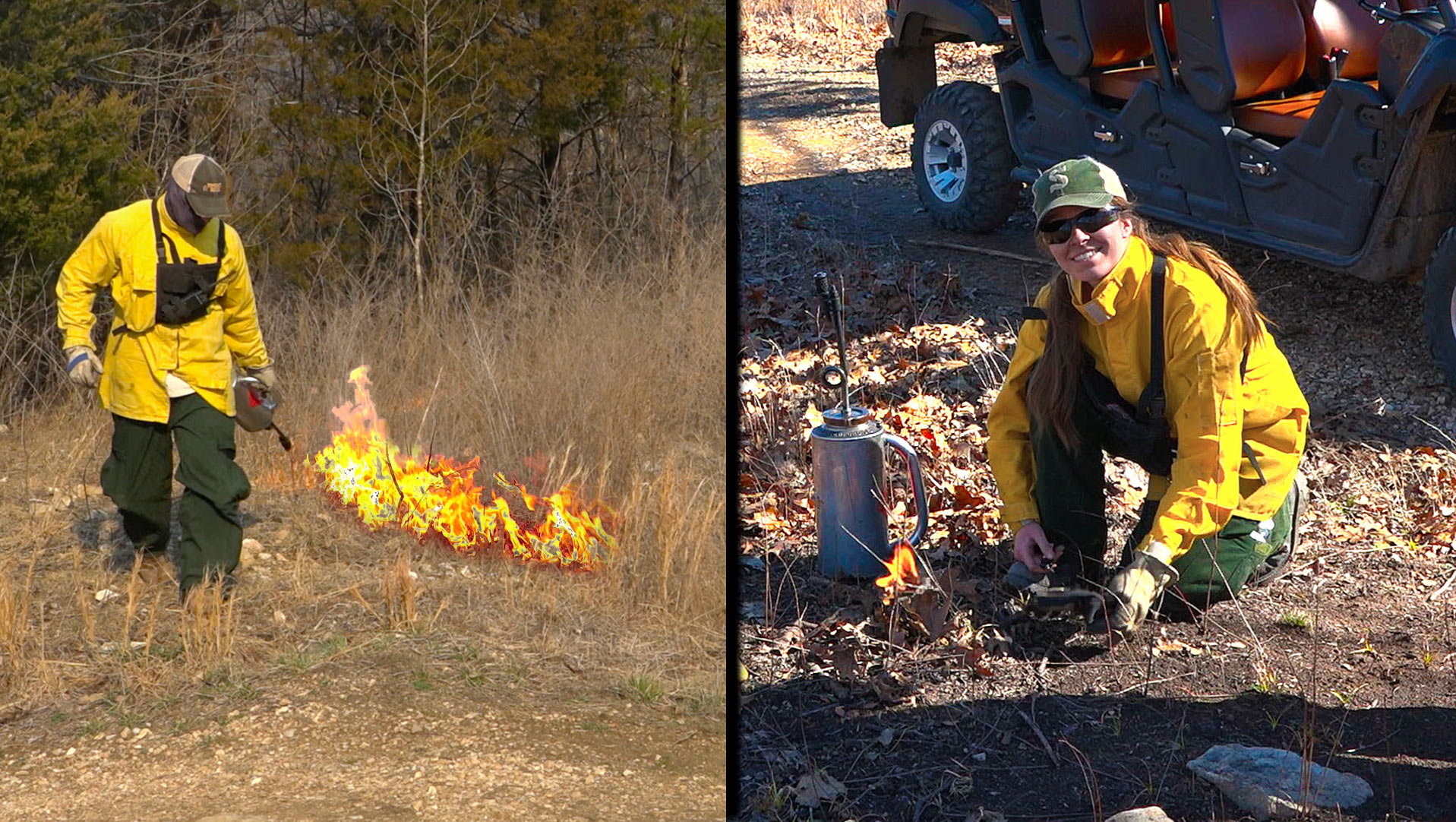
For more information on internships check out the “internships” link on the bottom right side of our website.
While an internship may not sound appealing at first, it has long term effects in a job search. Regardless of what you’re called to do in life, it will benefit you to live humbly and build up your experience as you pursue a career. Remember what Jesus said in Matthew 6:26, “Look at the birds of the air: they neither sow nor reap, and yet your heavenly Father feeds them. Are you not of more value than they?” God has provided me with a way to eat and pay my bills as I work and He can do the same for you.
My time at GrowingDeer has given me experiences that will help me be a better wildlife biologist. This internship has truly been a blessing! I encourage all high-school and college students to try an internship.
Enjoy Creation,
Jessica
How To Get Great Turkey Pictures
We receive lots of questions about how we get quality pictures of turkeys.
We scout and look for turkeys or turkey sign. Once we determine an area turkeys are using we place a Reconyx camera in that area and attempt to have it facing north. The sun is never in the north (in the USA) so the camera is never pointed into the sun. Images from cameras pointed into the sun are often so blurry they are low quality.
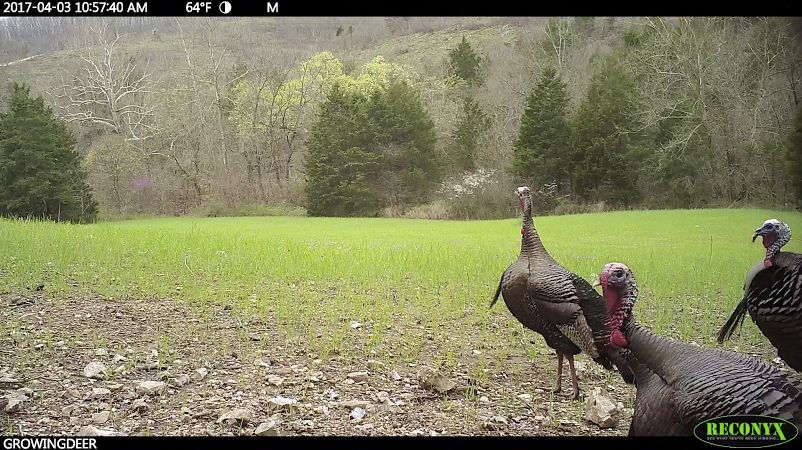
An additional step we take is to place the camera low on the tree – about the height of a turkey. Turkeys seem to look best when viewed from their level.
Trail cameras can be a great tool for scouting for turkeys. For M.R.I. (most recent information) I keep a BoneView in my turkey vest. BoneView is a card reader designed specifically for smart phones. When I walk by a trail camera while turkey hunting I simply pull the card and view the pictures on my phone.
Enjoy Creation,
Grant



